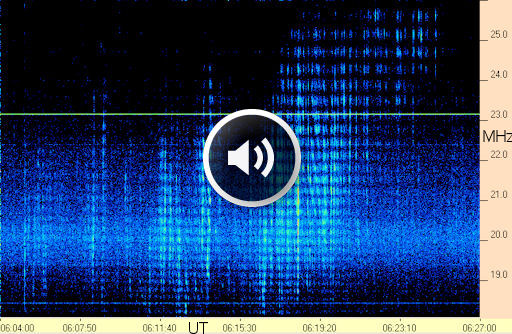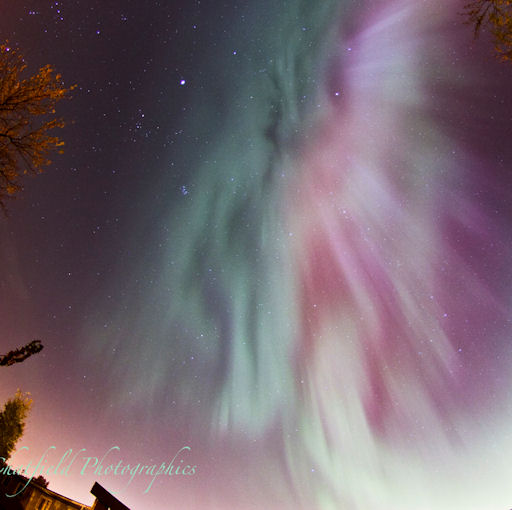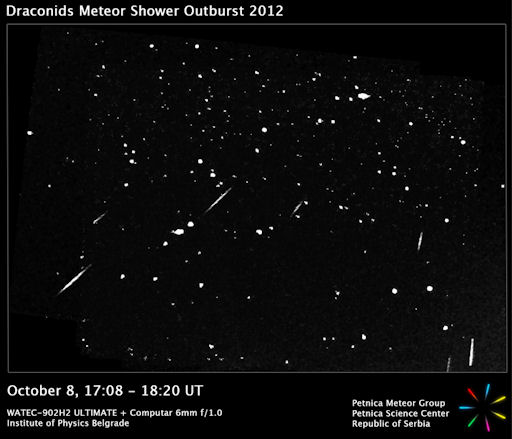QUIET SUN: With no sunspots actively flaring, the sun's x-ray output has flatlined. Solar activity is low and likely to remain so throughout the weekend. Solar flare alerts: text, voice.
GEOMAGNETIC STORM: A G1-class geomagnetic storm broke out during the early hours of Oct. 13th, igniting bright auroras over Canada. Colin Chatfield sends this picture from Saskatoon, Saskatchewan:
"This is from my backyard around 5:00a.m. this morning," says Chatfield. "Never have I seen the auroras so bright, especially from within the city. They were astounding, with purple visible to the naked eye."
The source of the storm was a knot of south-pointing magnetism from the sun. The knot drifted past Earth, bumping into our own planet's magnetic field. This caused a crack to open in Earth's magnetic defenses. Solar wind poured in to fuel the auroras.
More auroras are in the offing. NOAA forecasters estimate a 40% chance of strong polar geomagnetic storms on Oct. 14th when a solar wind stream is expected to blow past Earth. High-latitude sky watchers shuld be alert for auroras. Aurora alerts: text, voice.
RADIO STORM ON JUPITER: Two nights ago, there was a storm on Jupiter--a radio storm. Amateur radio astronomer Thomas Ashcraft recorded the event using a shortwave radio telescope located in New Mexico. Click on the dynamic spectrum (a plot of intensity vs. frequency vs. time) to hear the whooshing, crackling, popping sounds that emerged from his telescope's loudspeaker:

Dynamic spectrum courtesy of Wes Greenman, Radio Alachua Observatory
"Listen to the recording in stereo," advises Ashcraft. "I recorded the audio from two separate radios at 21.1 MHz and 20.9 MHz, so there is a stereo spatial effect from the frequency drift of the emissions."
Jupiter's radio storms are caused by natural radio lasers in the planet's magnetosphere that sweep past Earth as Jupiter rotates. Electrical currents flowing between Jupiter's upper atmosphere and the volcanic moon Io can boost these emissions to power levels easily detected by ham radio antennas on Earth. Jovian "S-bursts" and "L-bursts" mimic the sounds of woodpeckers, whales, and waves crashing on the beach. Here are a few audio samples: S-bursts, S-bursts (slowed down 128:1), L-Bursts
Now is a good time to listen to Jupiter's radio storms. The distance between Earth and Jupiter is decreasing as the giant planet approches opposition on Dec. 3rd; the closer Jupiter gets, the louder it gets. NASA's Radio Jove Project explains how to build your own receiver.
DRACONID METEOR OUTBURST: On Oct. 8th, more than 2000 meteors per hour exploded across the skies of North America and Europe. Radars in Canada and Germany detected the outburst of Draconids, yet sky watchers saw almost nothing. The meteors were too dim for human vision. Nevertheless, a meteor camera in Serbia captured visual evidence that an outburst was underway:
These seven Draconids appeared over the Petnica Science Center at the Institute of Physics in Belgrade. They were the bright "tip of the iceberg" marking the presence of an underlying stream of much dimmer and more numerous meteoroids. Researchers believe the outburst happened when Earth passed through a stream of dusty debris from Comet 21P/Giacobini-Zinner, parent of the annual Draconid meteor shower. This particular stream was laid down by the comet when it passed by Earth's orbit in 1959.

![]()
Solar wind
speed: 509.9 km/sec
density: 1.1 protons/cm3
explanation | more data
Updated: Today at 1536 UT
![]()
X-ray Solar Flares
6-hr max: B8 1258 UT Oct13
24-hr: B8 1258 UT Oct13
explanation | more data
Updated: Today at: 1459 UT
![]()
![]()
![]()
Daily Sun: 13 Oct 12
![]()
![]()
Sunspot 1589 poses a threat for M-class solar flares. Credit: SDO/HMI
![]()
![]()
![]()
Sunspot number: 89
What is the sunspot number?
Updated 12 Oct 2012
Spotless Days
Current Stretch: 0 days
2012 total: 0 days (0%)
2011 total: 2 days (<1%)
2010 total: 51 days (14%)
2009 total: 260 days (71%)
Since 2004: 821 days
Typical Solar Min: 486 days
Update 12 Oct 2012
The Radio Sun
10.7 cm flux: 117 sfu
explanation | more data
Updated 12 Oct 2012
![]()
![]()
![]()
Current Auroral Oval:
![]()
Switch to: Europe, USA, New Zealand, Antarctica
Credit: NOAA/POES
![]()
![]()
![]()
Planetary K-index
Now: Kp= 5 storm
24-hr max: Kp= 5 storm
explanation | more data
![]()
Interplanetary Mag. Field
Btotal: 8.8 nT
Bz: 2.7 nT south
explanation | more data
Updated: Today at 1536 UT
![]()
![]()
![]()
Coronal Holes: 12 Oct 12
![]()
![]()
Solar wind flowing from the indicated coronal hole should reach Earth on Oct. 14-15. Credit: SDO/AIA






